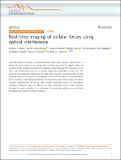Files in this item
Real-time imaging of cellular forces using optical interference
Item metadata
| dc.contributor.author | Meek, Andrew Thomas | |
| dc.contributor.author | Kronenberg, Nils Michael | |
| dc.contributor.author | Morton, Andrew | |
| dc.contributor.author | Liehm, Philipp | |
| dc.contributor.author | Murawski, Jan | |
| dc.contributor.author | Dalaka, Eleni | |
| dc.contributor.author | Booth, Jonathan Hunter | |
| dc.contributor.author | Powis, Simon John | |
| dc.contributor.author | Gather, Malte Christian | |
| dc.date.accessioned | 2021-06-15T12:30:06Z | |
| dc.date.available | 2021-06-15T12:30:06Z | |
| dc.date.issued | 2021-06-11 | |
| dc.identifier | 273902502 | |
| dc.identifier | 5e7dbb60-20c1-49c2-b3e2-da7ee3381c9a | |
| dc.identifier | 000663756500001 | |
| dc.identifier | 85107739075 | |
| dc.identifier.citation | Meek , A T , Kronenberg , N M , Morton , A , Liehm , P , Murawski , J , Dalaka , E , Booth , J H , Powis , S J & Gather , M C 2021 , ' Real-time imaging of cellular forces using optical interference ' , Nature Communications , vol. 12 , 3552 . https://doi.org/10.1038/s41467-021-23734-4 | en |
| dc.identifier.issn | 2041-1723 | |
| dc.identifier.other | ORCID: /0000-0003-4218-2984/work/95772297 | |
| dc.identifier.other | ORCID: /0000-0002-4857-5562/work/95772548 | |
| dc.identifier.other | ORCID: /0000-0003-3306-7466/work/95772720 | |
| dc.identifier.uri | https://hdl.handle.net/10023/23363 | |
| dc.description | Funding: This research was financially supported by an EPSRC Programme Grant (EP/P030017/1), by the European Research Council under the European Union’s Horizon 2020 Framework Programme (ERC StG ABLASE, 640012), and by the EPSRC Doctoral Training Partnership (EP/M508214/1, EP/L505079/1). M.C.G. acknowledges funding from the Alexander von Humboldt Stiftung (Humboldt-Professorship). | en |
| dc.description.abstract | Important dynamic processes in mechanobiology remain elusive due to a lack of tools to image the small cellular forces at play with sufficient speed and throughput. Here, we introduce a fast, interference-based force imaging method that uses the illumination of an elastic deformable microcavity with two rapidly alternating wavelengths to map forces. We show real-time acquisition and processing of data, obtain images of mechanical activity while scanning across a cell culture, and investigate sub-second fluctuations of the piconewton forces exerted by macrophage podosomes. We also demonstrate force imaging of beating neonatal cardiomyocytes at 100 fps which reveals mechanical aspects of spontaneous oscillatory contraction waves in between the main contraction cycles. These examples illustrate the wider potential of our technique for monitoring cellular forces with high throughput and excellent temporal resolution. | |
| dc.format.extent | 11 | |
| dc.format.extent | 2580064 | |
| dc.language.iso | eng | |
| dc.relation.ispartof | Nature Communications | en |
| dc.subject | Cell adhesion | en |
| dc.subject | Cellular imagining | en |
| dc.subject | IMagining techniques | en |
| dc.subject | Interference microscopy | en |
| dc.subject | QH301 Biology | en |
| dc.subject | QC Physics | en |
| dc.subject | T Technology | en |
| dc.subject | DAS | en |
| dc.subject.lcc | QH301 | en |
| dc.subject.lcc | QC | en |
| dc.subject.lcc | T | en |
| dc.title | Real-time imaging of cellular forces using optical interference | en |
| dc.type | Journal article | en |
| dc.contributor.sponsor | EPSRC | en |
| dc.contributor.sponsor | European Research Council | en |
| dc.contributor.institution | University of St Andrews. School of Physics and Astronomy | en |
| dc.contributor.institution | University of St Andrews. Centre for Biophotonics | en |
| dc.contributor.institution | University of St Andrews. School of Medicine | en |
| dc.contributor.institution | University of St Andrews. St Andrews Bioinformatics Unit | en |
| dc.identifier.doi | 10.1038/s41467-021-23734-4 | |
| dc.description.status | Peer reviewed | en |
| dc.identifier.grantnumber | EP/P030017/1 | en |
| dc.identifier.grantnumber | 640012 | en |
This item appears in the following Collection(s)
Items in the St Andrews Research Repository are protected by copyright, with all rights reserved, unless otherwise indicated.

